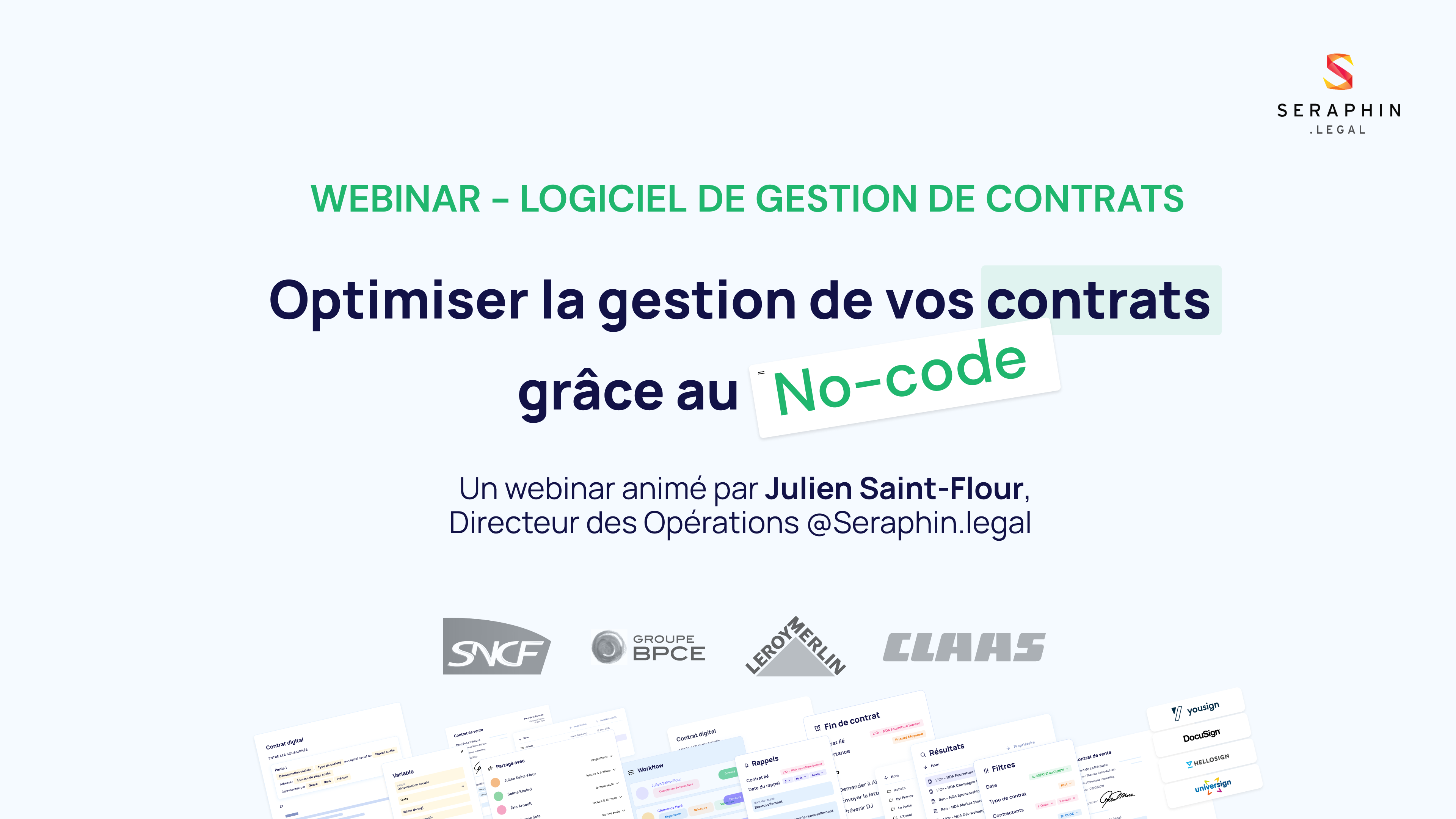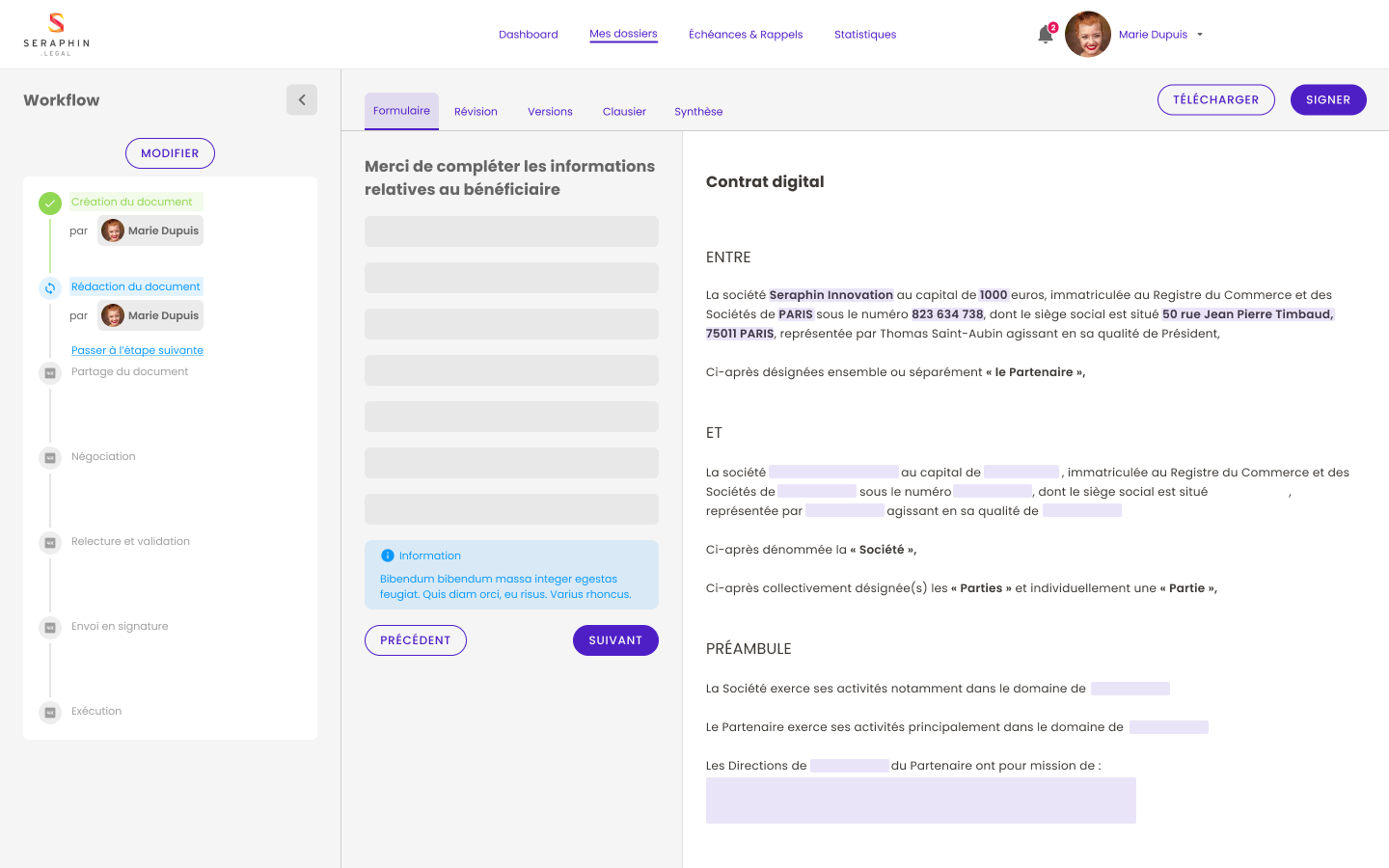Seraphin.legal s mission is to simplify, streamline and secure the management of your contracts.
We create, reinvent and improve uses through functionalities adapted to your needs.
While our objective remains to simplify contractualisation, we recognise our share of responsibility in the use of terms sometimes associated with a legaltech novlanguage.
So, to avoid any confusion, we thought it would be a good idea to define all these terms.
Whether you are a Seraphin.legal user , exploring for the ideal contract management software or simply curious, we hope that this glossary will help you to see a little more clearly.
To avoid repeating ourselves, let's start with an initial announcement. If you are wondering if there is a difference between contract management softwarecontract management software, contract management software, contract lifecycle management software...Good news, there is none!
Contract management software
Let's start with the term you hear most often when it comes to the digitisation of contracts.
A contract management software is an application whose main objective is to optimise the management of contractual flows in companies.
Unlike a general-purpose DMS, contract management software specifically covers the entire life cycle of the contract.
Through technological solutions called "functionalities", the contract management software meets the needs identified in the company.
Term used in English: Contract Management Software
Synonyms: Contracts software, GED Contracts
Users: Legal teams and all those involved in contractualisation in companies
Example of tools : Seraphin.legal
GED Contracts
What is the difference between a Contracts DMS and a contract management software? None, except for the terms used to define them.
EDM stands for Electronic Document Management. It would be more appropriate to speak of ECM when talking about contracts: Electronic Contract Management.
| EDM features | GED Contracts Features |
|
|
Smart Contracts
The Smarts Contracts (French: contrats intelligents) refers to the use of computer protocols embedded in a blockchain to
Smarts Contracts are computer programs, based on blockchain technology, that trigger automated actions whenever an event specified in the contract occurs.
It is therefore a classic contract, but its technical transposition allows actions to be triggered without human intervention.
👉 Let us take the example of delay in the performance of a contractual obligation giving rise to the payment of penalties.
- Triggering event : Non-performance of the contractual obligation
- If LATE is late in delivering the "Expected"products
- Action: Payment of a penalty
- Then payment of a penalty of 50€ per day by direct debit
👉 Another example in the case of a professional football player's contract:
- Triggering event : Achievement of a contractual objective
- If the player scores at least 10 goals
- is responsible for at least 5 assists
- and has started 75% of the games
- before the winter market
- Action: Payment of a target bonus
- Then payment of a target bonus in January 2022
No-code contract automation
Automating your contracts without writing a single line of code? It is possible.
Apart from the use case of contracts, it is the ability to automate certain actions, certain workflows or to create an application from scratch without writing a single line of code.
Applied to contracts, it is the automation of contract templates without prior IT skills.
At Seraphin.legalwe have chosen the no-code to give our clients autonomy in the automation of their contractual processes and no longer be dependent on any intervention from developers or services provided by a provider.
How does it work?
The no-code editor allows to automate a contract thanks to a system of blocks, variables and conditions.
- Blocks represent a dynamic form step with several variables
- The variables are the customisable fields on your contract
- Display conditions allow you to make a block of text appear based on other triggers (e.g. a clause that only appears if the number of employees in a company that is party to the contract is greater than 10).
Once the template is automated, it is generated from the contract generator.
Contract Generator
The contract generator is the Siamese twin of the no-code editor.
Once the template has been automated, you can use the contract generator to operate your templates.
It is materialized by :
- A form on the left of your screen from which data is entered
- A contract on the right-hand side of your screen that updates in real time each time you enter information on your form
Autocompletion of contracts
An efficient contract management software must be connected to the tools used by the company. Salesforce, Sage, Hubspot etc... Most of the information contained in your contracts is often first processed by your team members on other tools.
L'auto-completionAutocomplete is a feature that allows you to pre-populate fields in your form from your information system.
This allows you to save time when entering information about your co-contractor such as the SIRET number, the RCS, the company name, the address of the registered office, etc.
The two possible sources are
- by connecting your CRM or any other business tool to the software Seraphin.legal by API
- by importing your databases in Excel format
Collaborative review
The collaborative review takes place as part of the negotiation of your contract.
It allows you to negotiate with your co-contractors in a collaborative manner and in real time thanks to the tracking of changes and comments as in a Google Doc or Word Online.
Unlike these two tools, all the information stored in the context of the negotiation (thread of activity, action of each of the participants, etc.) will be archived and can be used in the event of an audit or litigation.
In addition to archiving, the collaborative review on a contract management software allows you to have statistical data on :
- Average time to negotiate a contract
- The volume of contracts "blocked" in the negotiation phase
- The volume of contracts negotiated per person
In short, collaborative review allows you to put an end to the dispersal of your contracts by email: your strategic information will no longer be put at risk, all exchanges between your employees and your contractors will be recorded and gathered in one place around the contract.

History and comparison of versions
There is nothing worse than signing the wrong version of a contract because of bad version naming.
Version history
The version history allows you to say goodbye to :
- the confusion of versions
- untimely overwriting of files
- validation and signing of the wrong version of the contract
This feature allows you to save and name successive versions of your contracts. You will be able to restore them at any time.
Comparison of versions
"Our co-contractor inserted a clause to our disadvantage at the last minute and without warning us.
Compare two versions of a document simply to identify changes that have been made.
Since an example speaks for itself, here is what you can do to avoid this type of functionality.
Contractual search engine
Could you please export to me all contracts above €50,000 with clause X signed after 22/02/2021?
You are often asked to extract this kind of data in a very short time. However, without an automated workflow, you will not be able to reliably retrieve this data without spending all day on it.
Hence the major importance of a contract search engine, integrated to your contract management software. It allows you to drastically reduce the time spent responding to this type of request.
The contractual search engine is a component of your contract library which allows you to re-use all the data compiled earlier in the contract life cycle.
All the fields completed during the generation of the contract can be exported using filters. The same applies to the information entered in your contract forms.
Here are some examples of filters:
- Date of creation of the contract
- Date of signature
- Type of contract
- Purpose of the contract
- Contract amount
- Clause
- Country
- Language
- Project
- Contract status: Draft, Under negotiation, Under signature, Signed, Refused
- Creator
- Contributor
- Key words inserted in the contract
Finally, the search engine also allows you to save your most recurrent queries and relaunch them with one click.

Automated contract files
A contract form is a brief sheet summarising the information essential to understanding the contract. Like a reader's guide, it aims to give an overview of a contract without having read it.
Contract records can be generated automatically or created manually.
When they are created automatically, the contract forms are made up of pre-determined fields. The fields are filled in automatically from the information you have entered in your contract.
When created manually, contract records are made up of information that is not necessarily in your contract but that you consider relevant to allow any employee to take control of the contract.
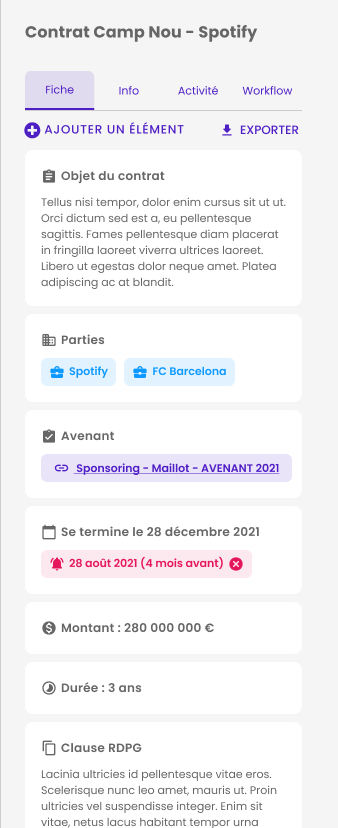
Electronic Signature
The electronic signature is a technology that allows you to sign a document online in a few minutes while providing proof of the signer's consent.
In most cases, the contract management software integrates third-party electronic signature solutions.
It is therefore recommended that the electronic signature is in-app.
This allows you to go to signature without exporting your contract from a contract management software A and then importing it into an electronic signature software B. Beyond this practical aspect, it will also allow you to compile statistical data: average signature time, percentage of signed contracts vs. contracts awaiting signature, etc.

Deadlines manager
- Deadline calendar: To view all your contract deadlines in a chronological dashboard but also in order of priority.
- Deadline Reminder: Allows you to set reminders on your contract deadlines and receive notifications so you don't miss any.
- Deadline sheets: Allows you to work collaboratively on a deadline with your team members by associating a list of tasks and additional documents.
More concretely, if you are not using contract management software, your contract data is currently static. This means that your contracts are full of strategic information, but you have to extract it manually to use it. This leads to the following difficulties in business:
- The contractual data is static and does not allow for automatic alerts
- Contractual data are scattered in different unsuitable excel files
- The Legal Department cannot predict the workload on current contracts in advance
- Loss of information and visibility leads to loss of strategic opportunities
The deadline manager will allow you to be informed at the right time of the occurrence of a deadline and to be able to determine, as a team, an appropriate action plan.
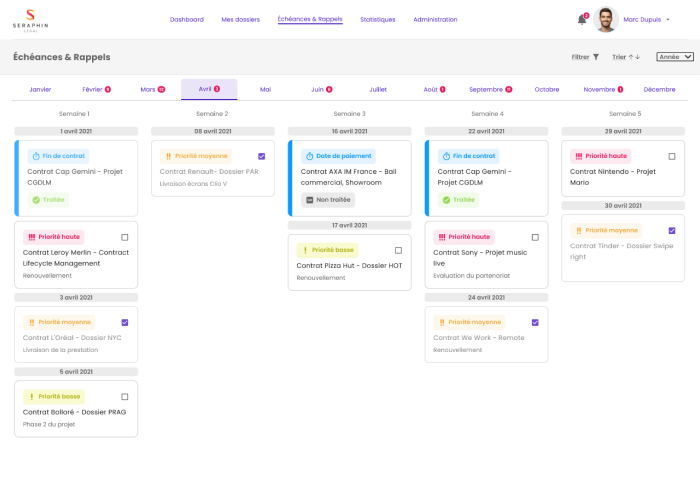
Contract Management KPI
The Contract Management KPIKey Performance Indicators are all quantitative or qualitative data that measure the operational performance of a team, a process or a project.
"Without workflow and digital tools, it will be almost impossible for you to measure anything." Emilie Letocart-Calame, President of Calame - The Legal Ops Company
Indeed, the implementation of a statistical dashboard and the delivery of regular reporting on contractual activity is complicated by the dispersion of data in different tools. The data provided is also unreliable because it is entered manually with a margin of human error.
It is therefore essential to exploit the data generated throughout the contract life cycle, from inception to execution, to achieve the following objectives
- Measuring performance reliably
- No more time wasted compiling scattered data (1 to 2 hours per week)
- Provide visibility on the progress of your negotiations
- Putting the numbers on your side to make the best decisions, provide the best advice and justify the need for a project.
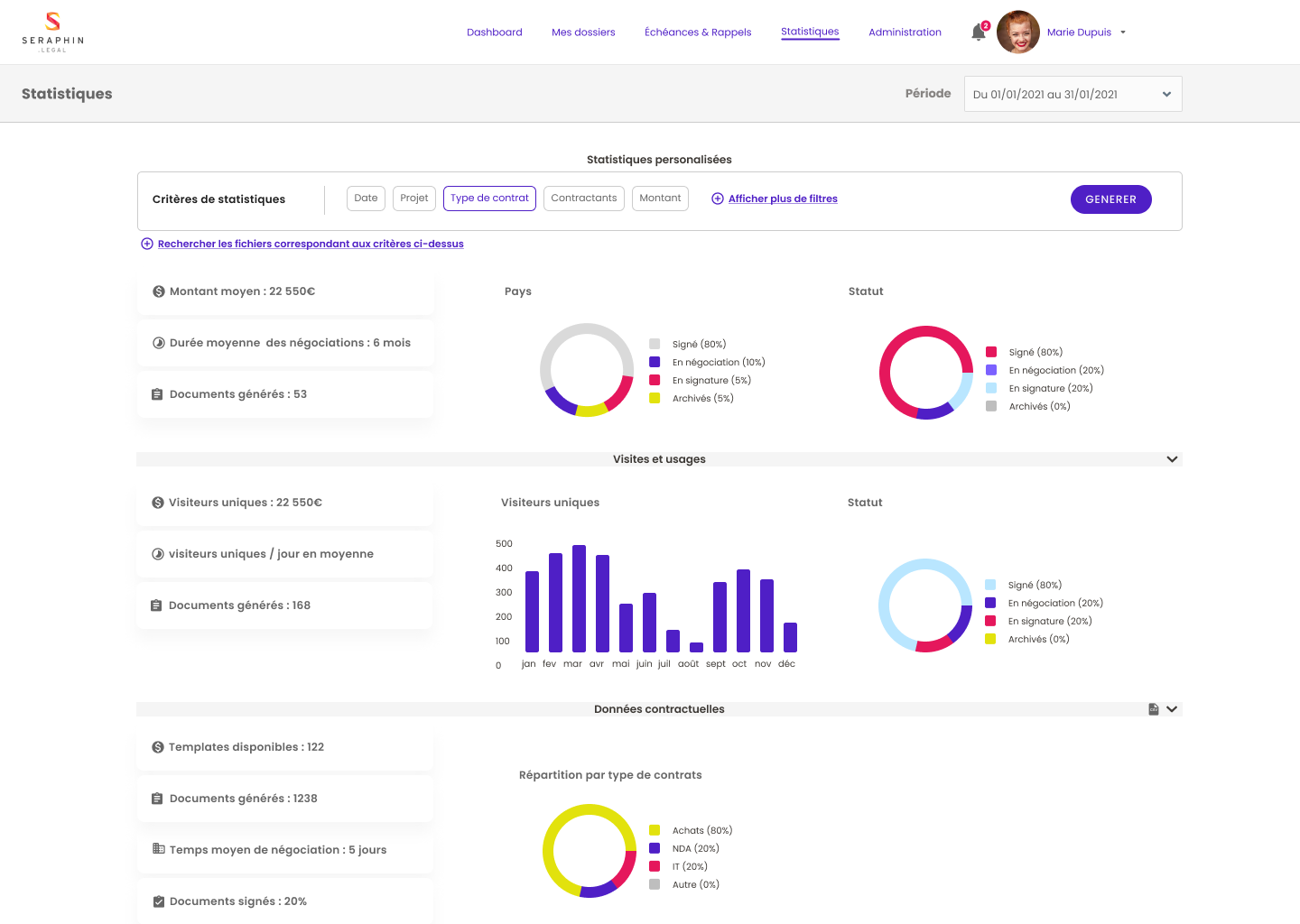
Contract Management API
An application programming interface (API) is a software interface that allows software A to be connected to software B to exchange data and/or functionality.
Applied to contracts, an API allows :
- Transfer contract and contractual workflow data into your software tools
This allows you to be aware in real time of movements on your contracts and to synchronise this information with your business applications. For example, integrate your customers' CRM data directly into their contracts or integrate your contract data directly into your invoicing tools.
- To use software features without developing them from scratch.
On Seraphin.legal for example, this allows you to integrate one or more of our features into your own application or customer journey. Let's take the example of an application specialising in the sale of art objects. The company can integrate the creation and signing of the sales contract into its user journey. The functionality matches your colours, your brand image, it allows you to guarantee a uniform user experience and to secure your operation by keeping the customer's trust.
Choose to combine contractual performance and legal certainty
No commitment, no credit card.




